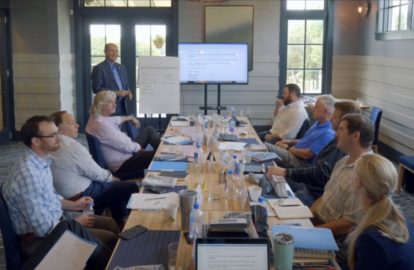The decision to begin exit planning is a momentous one. You are no longer thinking, pondering, procrastinating, delaying, or flat-out avoiding. You’re ready to begin a process to help ensure a rewarding close to one chapter of your life and a successful start to the next. But…what now? Exiting your business is complex; and many owners don’t know where to start. The answer: at the beginning – and one play at a time.
The Beginning
NAVIX Consultants CEO Patrick Ungashick begins his essential guide Dance in the End Zone: The Business Owner’s Exit Planning Playbook not with advice or strategies – but with a touchdown. Pro wide receiver Elmo Wright is recognized as the first player to perform an end zone dance. Wright later said, “I’ve accomplished a lot in my life, but what happened in the end zone is what defines my career.”
And it defines your career. Ungashick writes, “Your exit should be the crowning achievement of a career, the fulfillment of financial and family dreams, the next chapter in a business legacy. It is a cause for celebrating – for dancing in the end zone.”
The key to ensure a successful exit: “Don’t wait til you’re on the one-yard line.” In other words, don’t wait until you’re injured, until you’re too ill, until you have to stop working to care for a spouse, until you’re simply burned out and ready for a change. Plan ahead – and even better, begin with the end in mind! Ideally, your planning process should begin five to ten years prior to your exit. But even three years can still confer significant benefits.
End Zone Questions
Will you dance in the end zone, or make it in by the skin of your teeth? It’s up to you. Answering the following seven questions – sooner rather than later – can make the difference:
- When do you want to exit? At age 60? 65? 70? Your timeline determines how much time you have to plan – and it also determines which strategies and tactics are available to you. The more time, the more options you have.
- What is your most likely exit strategy? You have shed blood, sweat, and tears to grow your business; its future is an important, and often emotional, consideration. Do you want to pass the business to family, sell to employees, partners, or a third-party, or do you want to liquidate? Determine which option suits your situation – and whether your current business strategy supports that.
- What’s your Exit Magic NumberTM calculation? How much do you need to achieve financial freedom after your exit? Or, put another way, how much do you need to support your lifestyle costs after exit? This is your Exit Magic NumberTM. Many owners have a number in mind – and many are off by several million dollars. Your CPA or financial planner can help you determine an accurate figure, given taxes, inflation, and expenses.
- Where will it come from? Where is your Exit Magic NumberTM money actually going to come from? It’s risky to assume you’ll receive it all when you sell the business. To use our football metaphor, it’s like banking the future on a Hail Mary pass. Instead, employ strategies that enable you to transfer current cash and future equity into personal wealth.
- What risks do you face before you exit? In other words, what obstacles can throw themselves in the way of your end zone dance? Will a key employee leave? Will your partner refuse to buy your share or sell his? Will you face health issues? Will your planned successor (e.g. a child, a partner) choose not to inherit the business? Risk management is key.
- What do you want to do after you exit? Do you want to open another business? Volunteer in your community? Travel? Write your memoirs? Take up golf? Plan not only for the financial aspect of exit, but how you will spend your time after.
- Who’s on your team? Elmo Wright couldn’t have scored that touchdown – or celebrated with that fateful dance – “if his team never huddled up or used a playbook.”
You need to build your own exit planning team. Huddle up with your CPA, attorney, financial planner, family, and, perhaps most important, an exit planning strategist. This professional acts as your quarterback throughout the planning process – freeing you to work on your business every day to maximize profits and satisfaction.
Blocking the End Zone
The 7 End Zone Questions are tough, there’s no way around it. Calculating your Exit Magic NumberTM, converting wealth, reducing tax implications, managing risk… These are all areas in which your team can support and guide you.
But there are other questions that require deep introspection. Questions only you can answer, with input and insight from family, advisors, mentors, teammates. Most owners falter when it comes to when and how to exit, as well as what they will do after. They are difficult questions to answer, and that’s all the more reason to begin tackling them now.
As Patrick Ungashick writes in his whitepaper, “The Exit Magic NumberTM: The Most Important Number to A Business Owner:”
Benjamin Franklin is said to have coined the phrase that ‘nothing is certain except for death and taxes.’ Respectfully, Mr. Franklin missed something. Another certainty is that all owners of closely held businesses will exit their business one day.
Exiting your business is a certainty. Exiting in a successful and rewarding way – or dancing in the end zone – is not. Unless. You create certainty when you recruit a team of exceptional players, including a first pick quarterback, study the NAVIX playbook, and execute each play with your end goal in mind.


